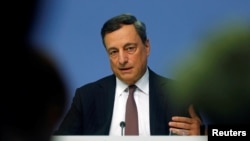The European Central Bank left its stimulus measures on hold Thursday and warned governments that they need to do more to help the eurozone economy grow and push inflation up to healthier levels.
The bank kept its key interest rates on hold and decided against extending the duration of its existing bond-buying stimulus program as it monitors the impact it is having on the economy.
President Mario Draghi told a news conference that governments' implementation of “structural reforms needs to be substantially stepped up to reduce structural unemployment and boost potential output growth.”
He added that countries that eurozone governments that have the capacity to spend more should do so.
The central bank faces stubbornly low annual inflation of only 0.2 percent despite pumping 1 trillion euros ($1.1 trillion) in newly printed money into the banking system through bond purchases since March, 2015. The purchases, made at a rate of 80 billion euros a month, are set to continue at least through March, 2017 or until inflation convincingly picks up.
The bank left that earliest end date unchanged. Some analysts thought the bank might commit to a longer program.
The central bank's 25-member governing council left its benchmark rate at zero and its rate on deposits from commercial banks at minus 0.4 percent.
Its staff's new economic estimates showed inflation is expected to increase only gradually. They trimmed their inflation projection for next year to 1.2 percent from 1.3 percent, but left its outlook for 2018 unchanged at 1.6 percent. That indicates it sees itself getting gradually closer to its goal of just under 2 percent over the longer term.
The ECB faces worries about the economy on several fronts. While the eurozone is enjoying moderate growth, inflation continues to lag well below target, despite a raft of stimulus measures, and unemployment is high at 10.1 percent and falling only slowly.
Its stimulus measures so far have included cutting the benchmark interest rate to zero, and the rate on deposits from commercial banks to minus 0.4 percent. The negative rate is in effect a tax aimed at pushing banks to risk lending the money rather than stash it at the central bank's super-safe overnight deposit facility. It has also offered ultra-cheap loans to banks, and offered unlimited amounts of short-term credit against collateral.
Added uncertainty about future growth has come from the British vote June 23 to leave the European Union and its tariff-free trade zone. Britain would have to renegotiate its trade conditions with the EU over several years, and no one can say now how things will turn out. So far, economic data do not suggest a major impact.
Europe's banking system remains another drag on growth, as low profits overall and large amounts of bad loans in Italy constrict banks' ability to pass on the ECB's low interest rates to their clients.
But there are also concerns that the ECB cannot do it all and that governments will have to take difficult pro-growth steps if the eurozone is to enjoy a truly robust recovery. Draghi and other ECB officials have stressed that elected governments that have the money should be spending more on infrastructure and taking steps to reduce burdensome regulations that make it harder to start and grow a business.








